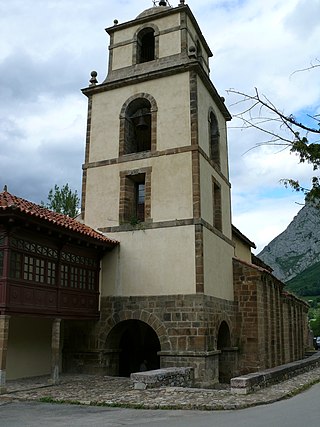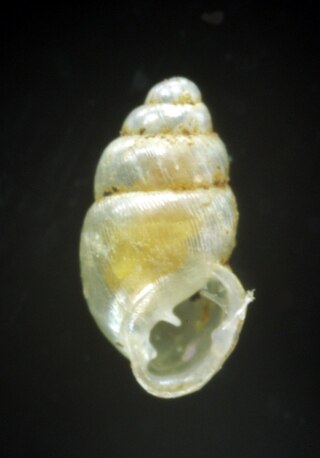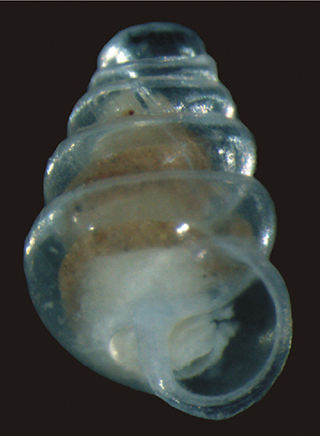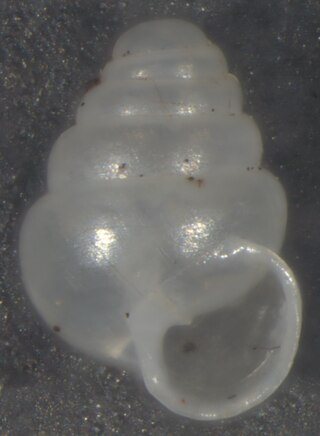
Asturias, officially the Principality of Asturias, is an autonomous community in northwest Spain.

The Velebit mountains of Croatia have several deep caves with some of the world's largest subterranean vertical drops.

Teverga is a municipality in the Autonomous Community of the Principality of Asturias, Spain. It is bordered on the north by Belmonte de Miranda, Grado, Yernes y Tameza, and Proaza; to the south by León province, to the west by Somiedo and to the east by Quirós and Proaza.

Carychiinae is a taxonomic subfamily of minute air-breathing land snails, terrestrial pulmonate gastropod mollusks.
Zospeum biscaiense is a species of air-breathing land snail, a terrestrial pulmonate gastropod mollusk in the family Ellobiidae, the salt marsh snails. This species is endemic to Spain.

Zospeum is a genus of air-breathing land snails, terrestrial pulmonate gastropod mollusks in the family Ellobiidae, the salt marsh snails.
Unthanks Cave Natural Area Preserve is a 171-acre (69 ha) Natural Area Preserve in Lee County, Virginia. It protects the entrance to Unthanks Cave, which houses significant biological diversity and a wide variety of invertebrate life. The cave's streams drain a significant karst area south of the Powell River.
The Sidrón Cave is a non-carboniferous limestone karst cave system located in the Piloña municipality of Asturias, northwestern Spain, where Paleolithic rock art and the fossils of more than a dozen Neanderthals were found. Declared a "Partial Natural Reserve" in 1995, the site also serves as a retreat for five species of bats and is the place of discovery of two species of Coleoptera (beetles).

Patella vulgata, common name the common limpet or common European limpet is a species of sea snail. It is a typical true limpet; a marine gastropod mollusc in the family Patellidae, with gills. This species occurs in the waters of Western Europe.

Zospeum tholussum or the domed land snail, is a cave-dwelling species of air-breathing land snails in the family Ellobiidae. It is a very small species, with a shell height of less than 2 mm (0.08 in) and a shell width of around 1 mm (0.04 in). Z. tholussum individuals are completely blind and possess translucent shells with five to six whorls. The second whorl of their shells has a characteristic dome-like shape. They are also extremely slow-moving and may depend on passive transportation through running water or larger animals for dispersal.

The Tito Bustillo Cave is a prehistoric rock shelter located in the small town of Ribadesella, in the autonomous community of Asturias, Spain. The cave was inhabited by humans (cro-magnon) before the year 10,000 BC. Due to the collapse of the rock, the original entrance to the cave was sealed thousands of years ago, which made it possible for preservation of objects, tools and wall paintings that were discovered in 1968. Based on those objects found in the cave, it is known that there was a significant human presence during the Magdalenian culture of the Upper Palaeolithic, but the cave was probably inhabited before that time.

Snails are considered edible in many areas such as the Mediterranean region, Africa, or Southeast Asia, while in other cultures, snails are seen as a taboo food. In American English, edible land snails are also called escargot, taken from the French word for 'snail,' and the production of snails for consumption is called snail farming or heliciculture. Snails as a food date back to ancient times, with numerous cultures worldwide having traditions and practices that attest to their consumption.
Zospeum vasconicum is a cave-dwelling species of air-breathing land snails.
Koreozospeum is a genus of small air-breathing land snails. It contains a single species, Koreozospeum nodongense.
Zospeum zaldivarae is a cave-dwelling species of air-breathing land snail.
Zospeum robustum is a cave-dwelling species of air-breathing land snails.

Zospeum manitaense is a cave-dwelling species of air-breathing land snail. Some individuals in this genus were previously described under the name of Zospeum amoenum, Zospeum isselianum or Zospeum pretneri.










